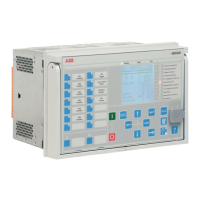Blocking logic
There are three operation modes in the blocking function. The operation modes are
controlled by the BLOCK input and the global setting in Configuration > System >
Blocking mode which selects the blocking mode. The BLOCK input can be controlled
by a binary input, a horizontal communication input or an internal signal of the relay
program. The influence of the BLOCK input signal activation is preselected with the
global
Blocking mode
setting.
The
Blocking mode
setting has three blocking methods. In the "Freeze timers"
mode, the operation timer is frozen to the prevailing value, but the OPERATE output
is not deactivated when blocking is activated. In the "Block all" mode, the whole
function is blocked and the timers are reset. In the "Block OPERATE output" mode,
the function operates normally but the OPERATE output is not activated.
The “Freeze timers” mode of blocking has no effect during the Inverse
reset mode.
4.5.4.5 Timer characteristics
PHAPTUV supports several operating curve types.
Table 604: Timer characteristics supported by IDMT operate curve types
Operating curve type
(5) ANSI Def. Time
(15) IEC Def. Time
(21) Inv. Curve A
(22) Inv. Curve B
(23) Programmable
4.5.4.6 Application
PHAPTUV detects low voltage conditions in power system elements, such as
generators, transformers, motors and power lines. Low voltage conditions are
caused by abnormal operation or a fault in the power system. PHAPTUV can be used
in combination with overcurrent protections. Other applications are the detection
of a no-voltage condition, for example, before the energization of a high voltage
line, or an automatic breaker trip in case of a blackout. PHAPTUV is also used to
initiate voltage correction measures, such as insertion of shunt capacitor banks, to
compensate for a reactive load and thereby to increase the voltage.
PHAPTUV can be used to disconnect damaged devices from the network. These are,
for example, electric motors, which are damaged when subjected to service under
low voltage conditions. PHPTUV deals with low voltage conditions at power system
frequency. Low voltage conditions can be caused by the following issues.
• Malfunctioning of a voltage regulator or incorrect settings under manual control
(symmetrical voltage decrease)
• Overload (symmetrical voltage decrease)
• Short circuits, often as phase-to-earth faults (unsymmetrical voltage increase).
1MRS757644 H
Protection functions
620 series
Technical Manual
657

